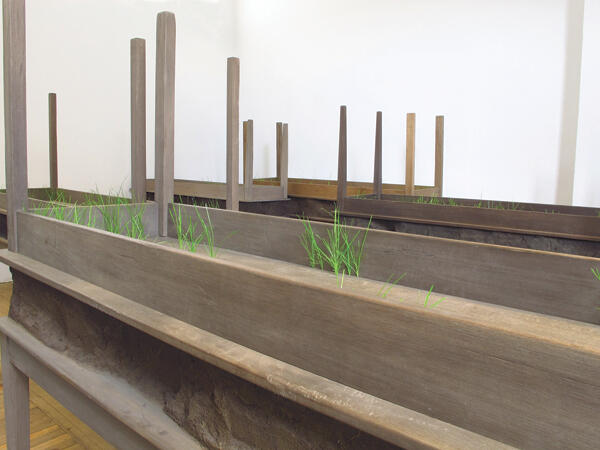Doris Salcedo
Flora, Bogotá
After being exhibited at the Calouste Gulbenkian Foundation (Portugal), the Museum of Modern Art in Malmö (Sweden), the National Museum of the 21st Century Arts - MAXXI (Italy), the Pinacoteca of the State of São Paulo (Brazil) and the University Museum of Contemporary Art of the National Autonomous University of Mexico UNAM (Mexico), a part of the installation Plegaria muda arrived at the Flora Foundation in Bogotá.

A series of tables organized in pairs, in which one of the two is placed on top of the other with the only aim of trapping a burial mound of earth, from which grass grows though the slits, make up this installation. With a discreet illumination, the ambiance is cold, maybe because of the presence of the earth, which at first view seems to be dry, but which maintains the necessary humidity to nurture the grass growing on it and pushing through the wood. These tables, each one the size of a standard coffin placed horizontally, occupy the space in a categorical way; walking among them becomes difficult, the closeness between them is uncomfortable. A series of feelings which on touring the installation confirm the artist’s words: Plegaria Muda seeks to face us with our repressed and unresolved mourning, with violent death when it is reduced to its total insignificance and is part of a reality used as a war strategy.
The presence of each of these live structures (in essence) represents, through the repetition of the same components – wood, earth, humidity and plant material–, the funerary ritual of each of the anonymous dead, all of them victims of an armed conflict maintained at any price, to whom it intends to offer a prayer. Part of her reflection in the making of this work (2008-2010) was focused on the false positives, or persons belonging to a disadvanteged, marginal population, which was attracted with the promise of holding a job, to be then murdered by military forces, with the aim of being presented as N.N guerrillas: killed in combat, in Salcedo’s words.
Her symbolic sculpture [full of] materials possessing and transmitting meaning, capable of establishing a communication with the viewer both at a physical and at a spiritual level, as expressed by her in 1988, make of Plegaria muda a place beyond art, a complex space in which silence, cold, the discreet illumination, predispose viewers to certain contemplation and respect, which only leads us to recognize, in the same way as the artist does, that this implacable and obsessive repetition of the burial mound, emphasizes the painful repetition of [all those] unnecessary deaths.
-
 View of the installation/ Vista de la instalación Plegaria muda / Photograph/Fotografía Camila Botero. Courtesy/Cortesía Flora.
View of the installation/ Vista de la instalación Plegaria muda / Photograph/Fotografía Camila Botero. Courtesy/Cortesía Flora.




